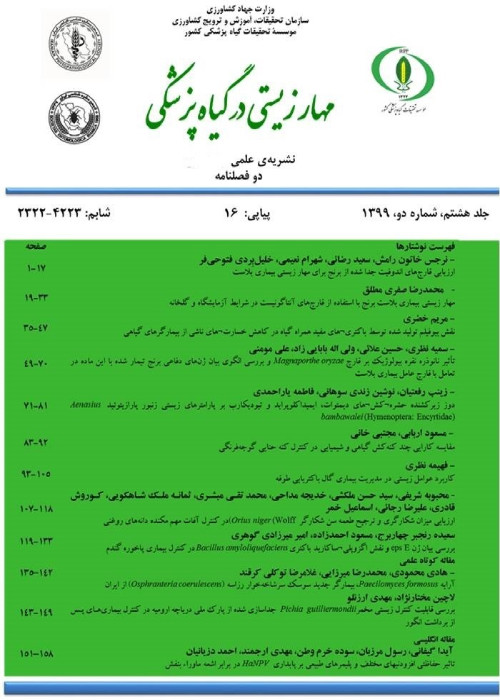Biological control of Sclerotium cepivorum, the causal agent of Allium (garlic) white rot disease, using Trichoderma and Talaromyces fungal antagonists in the laboratory and green house conditions
Author(s):
Abstract:
White rot caused by Sclerotium cepivorum (Berk).is one of the most widespread and damaging fungal diseases of garlic This diseas causes significant losses to garlic crops in Iran including Hamadan province evey year. At the present, the most common control control method of the disease is the use of chemical fungicides. This control measure is costly and contaminates the agricultural environment. Moreover, since the pathogen is soil-borne, this control method is not quite effective in controlling the disease. In this study, the effects of two antagonistic fungi including Trichoderma and Talaromyces as bio-control agents in the control of the causal fungal pathjogen were investigated under laboratory and greenhouse conditions. For this purpose, ten isolates of the antagonistic fungi, four isolates of T. harzianum (Th), two isolates of T. asperellum (Ta) and four isolates of T. flavus (Tf) were selected. The effects of antagonistic agents on the growth of the pathogen were evaluated in in vitro using dual culture method. Moreover, the impact of the volatile and non-volatile metabolites of the antagonistic agents on growth of the pathogen was also investigated. The results of the laboratory experiments showed that six isolates (two isolate from each species) significantly reduced the pathogen growth. Several new bioformulations were then developed and prepared using rice bran (RB) as an organic carrier and the most effective antagonistic isolates. The effectiveness of the developed bioformulations in controlling the white rot disease of garlic was studied under green-house conditions. The experiment was conducted as completely randomized design consisted of nine treatments (six bioformulations, one fungicide and two controls) each with four replications. The results of the greenhouse experiments indicated that regarding disease incidence and severity, there were significant differences among the treatments (P<0.05). The highest infection rate (53.82%) was observed in the positive control (treatment without biological agent or fungicide). The lowest infection rates were belonged tohealthy control (9.24%), fungicide (11.23%), RBTh1 (11.33%), RBTa2 (11.37%) and RBTh2(11.42%) respectively which were placed in the same statistical group.These overall results indicate that the biological control of Allium white rot disease using antagonistic fungi is possible as an effective alternative method.
Language:
Persian
Published:
BioControl in Plant Protection, Volume:2 Issue: 2, 2015
Pages:
13 to 24
magiran.com/p1468553
دانلود و مطالعه متن این مقاله با یکی از روشهای زیر امکان پذیر است:
اشتراک شخصی
با عضویت و پرداخت آنلاین حق اشتراک یکساله به مبلغ 1,390,000ريال میتوانید 70 عنوان مطلب دانلود کنید!
اشتراک سازمانی
به کتابخانه دانشگاه یا محل کار خود پیشنهاد کنید تا اشتراک سازمانی این پایگاه را برای دسترسی نامحدود همه کاربران به متن مطالب تهیه نمایند!
توجه!
- حق عضویت دریافتی صرف حمایت از نشریات عضو و نگهداری، تکمیل و توسعه مگیران میشود.
- پرداخت حق اشتراک و دانلود مقالات اجازه بازنشر آن در سایر رسانههای چاپی و دیجیتال را به کاربر نمیدهد.
In order to view content subscription is required
Personal subscription
Subscribe magiran.com for 70 € euros via PayPal and download 70 articles during a year.
Organization subscription
Please contact us to subscribe your university or library for unlimited access!




